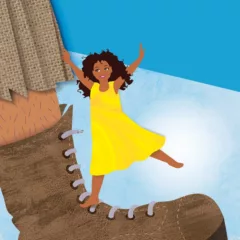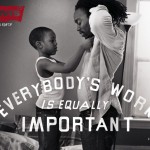I’m going to put three disparate items together — bear with me. It’s not that the two movies and book are comparable, they’re not. But each in its own way deals with some of core characteristics of youth — experimentation, loneliness, identity, and obsession with love, sex and death — and they all came across my radar very recently, so I’m packaging them as they came to me. James Franco’s Dangerous Book Four Boys and Lena Dunham’s Tiny Furniture are made by young artists. The Hunger Games is about youth, and of course, some other things as well.

Tiny Furniture is the tale of a new college grad, Aura, who returns from the Midwest to her family’s swank apartment in Tribeca. Her boyfriend broke up with her and she’s sad and confused about the future. The homecoming reception she gets from mom and sister (dad is not in the picture) is lukewarm. It’s a mystery whether this is because Aura is a problem child or whether mom and sister are just blase types.
In any event, Aura — as loose-y goose-y as her mom and sister are taut — is the girl who fell to earth, alienated and stumbling around trying to figure out her path. She is also very passive. She gets a job, but only through the agency of her best friend. She gets her YouTube video into a show in DUMBO, again, courtesy of her best friend.
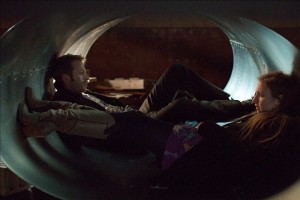
Told in an episodic, reality tv style,Tiny Furniture is a character study of the poor little rich girl and her family and few friends. But take away the trappings of wealth and privilege and you still have a story of contemporary youth. Aura makes mistakes; her judgment is poor. She’s so boy-crazy she takes in a stranger she met at a party, thinking he may be interested in her (he’s not, he’s just a freeloader). And later, she alienates a college girlfriend to run off with a jerk she has a crush on for a horrible one-night stand and sex outside in a large drainage pipe.
While Aura knows she wants to be a successful artist, you don’t believe in her ability to get there on her own. She’s guileless, wide-eyed and clueless in a world that is tough and unyielding.
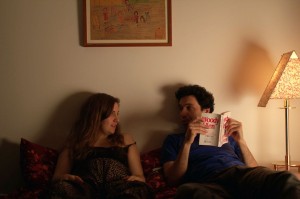
Tiny Furniture holds up a mirror to the life of privilege in lower Manhattan and nobody comes out unscathed (mom and sis are rigid and chilly; Aura is soft and indecisive; boys are crude, self-absorbed and unfeeling; dad is missing.) All the acting is unforced and graceful. Not a false note in the piece. And the apartment, where a great majority of the action takes place, with its floor to ceiling white cupborded-hallway and endless rooms, is almost a character in itself.
Nobody dies in Aura’s white, cupboard-filled wonderland but when the heroine climbs into bed with mom at movie’s end, after her horrible sex in the drain pipe experience, there’s a new level of knowledge written on her face, and some empathy from mom. At a time when more and more 20-somethings are returning home it’s a good tale for the times. The young filmmaker — Lena Dunham, the daughter of artists Laurie Simmons and Carroll Dunham (Laurie plays mom in the movie) — has found a way forward, presumably with some help, but don’t we all need that. Tiny Furniture is on Netflix for instant play, which is how I saw it.
The Dangerous Book Four Boys
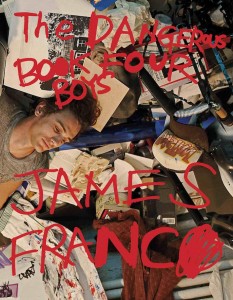
The same sense of entitlement and privilege found in the world of Tiny Furniture sits on James Franco’s The Dangerous Book Four Boys. I laughed when the book arrived. A Skira/Rizzoli coffee table book that retails for $50, its cover and insides are filled with images and text over which are scrawled words and scribbles, hearts and crude drawings — like some crazed teenage girl got hold of the galleys on the way to the printer. It took me a couple thumbings through to take the book by the movie star/artist seriously. Probably what did it was the essays, by Alana Heiss, Klaus Biesenbach and others, who give context to the apparent chaos between the covers, and dispel the idea that this book got made only because Franco is a star.
The book is the outcropping of Franco’s 2010 solo exhibition by the same name at the Clocktower Gallery in Lower Manhattan. While the book documents the exhibition of videos and sculpture in the show, it is quite a different beast than the show, whose pictures suggest an order and hierarchy that’s missing in the book. The book has to be read as another art project — the anarchic scribble scrabble of the artist commenting on his book. Consider it a James Franco zine.
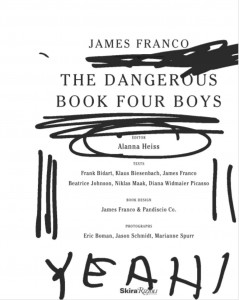
The book’s title takes off from the 2006 book The Dangerous Book for Boys, which itself parodies an old fashioned boy scout like manual — “how to build a treehouse, grow a crystal,” etc. Franco, it would appear, wants to teach boys how to explore their own sexuality, how to build a rocket, how to explode small playhouses, and how to be a larger-than-life movie star and make art and get it shown and get a book made to boot.
So, ok, according to the interview with Franco done by book editor and Clocktower Curator Alanna Heiss, the pieces in the show are autobiographical, depicting Franco and dealing with his memories of growing up boy in California. Franco’s answers to the questions are pretty lucid. The artist/actor says he has wonderful parents and went to great public schools but apparently he had trouble with the way boys are supposed to act: “Boys are “supposed” to do certain things like play sports and shoot guns and play with rocket ships, they are supposed to not like dolls and to be attracted to girls…” he says in the interview. He’s bringing his inner child with him on this journey (presumably that’s who’s doing the scribbling) and he’s looking back over his shoulder.
The pictures from the videos show a mix of art house-like material to action adventure movies. Little wooden houses get blown up; a little play house in a parking lot gets sledge-hammered; a plastic house gets melted. All of these might be tagged boyish pranks, except that artist Jackie Winsor, a woman, bombed the inside of a little box/house back in the 1970s, so maybe bombing houses is less gender-linked than it might seem.
Franco’s art house videos have a lot to do with sex and gender. But sex and gender are dealt with through humor and schtick, so it’s hard to know how seriously to take it. In Dicknose Goes to Paris, A William Faulkner character and his alter-ego Billy go to Paris with Franco, who plays Dicknose and wears a penis prosthesis on his face the whole time. In Star Trek, Kirk and Spock are portrayed by actors (presumably one is Franco) wearing masks. They are having sex, or trying to or at least talking about it. You can read the dialog in the book — it’s pretty funny. Spock’s sexual organs are in his fingertips, which Kirk can’t seem to get his mind around. Whether this is self-mocking or a reference to youthful hijinks is not clear. Franco is a Hollywood star, a sex symbol, and he has played hunks and gay hunks (in Milk). And by the way, the genital prosthesis he wears in Dicknose, it’s the very one he wore in a nude scene in Milk (although it surely wasn’t positioned on his face).
At bottom this is a not book for everyone. If you’re fascinated with the idea of a movie star who is doing some art, this is definitely for you. If you’re just into the the movie star James Franco, it’s for you, too. He’s an interesting guy, and while I haven’t seen his movies (except Spiderman, does that count?), I am fascinated that he’s working with Kalup Linzy, an artist who is all about gender issues and race and while it’s maybe too soon to tell, the collaboration might actually be inspired and the best thing Franco has attempted. See video of Linzy and Franco talking about working together.
JAMES FRANCO: THE DANGEROUS BOOK FOUR BOYS
Edited by Alanna Heiss with texts by Frank Bidart, Klaus Biesenbach, James Franco, Beatrice Johnson,
Niklas Maak, and Diana Widmaier Picasso
Hardcover w jacket / 9.25” x 12” / 208 pages / 200 color and B&W illustrations
$50 U.S., $55 Canadian, £30 UK
Skira Rizzoli / ISBN: 978-0-8478-3813-4 / Release date: April 2012
The Hunger Games
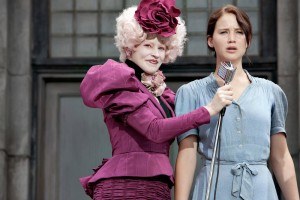
Entitlement seems to be the main story in the movie, The Hunger Games (you thought it was the gladiatorial games themselves?). It’s the entitled versus the disenfranchised, who are sacrificed for the pleasure of the powerful. Such a world, Auntie Em, take us home!
If you haven’t seen the movie, go — it’s pretty good; the acting’s good; the pacing, the scenery, all good. It’s got a great girl heroine and, as science fiction, it has a great evil empire to hiss at with its dastardly ways to subdue the populace. There’s some Wizard of Ozziness going on here, with an Emerald City-like magic place in the Capitol, seen first by our heroine out the window of a bullet train as she is whisked from her Depression-era hut in District 12 to be served up in the games. The citizens of the Capitol are not little people, but like the Munchkins and like the citizens of Emerald City, they are fancifully dressed and coifed and seem to lead a luxurious life filled with flowers and sapphire blue beverages and plenty to eat. No problems here but lots of televisions — the whole world is a stage and everywhere there are cameras.
The idea of a televised life with no secrets possible is not original, but it’s played effectively here, the way it was in The Truman Show — another movie about televised lives. Here, the hero and heroine grandstand their behavior to ingratiate themselves with the viewing audience, which, reality tv-like, can make their response known (because this is a magical land — they send gifts to their favorites, instead of merely voting for them).
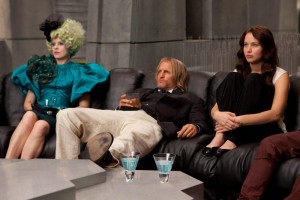
Because the bad guys are humans the plot is more in keeping with Orwell and Huxley than with the plots created for Twilight and Harry Potter. The visceral-ness of the story also reflects back on Lord of the Flies and The Dangerous Game, both of which involve humans hunting and killing other humans. The evil is real and it’s believable (well maybe not the dogs at the end). And the sad thing about entitlement, in this land, is you’re born into it. Seemingly, if you’re born outside the Capitol, even when you win the Hunger Games, it’s back to District 12 and hunting squirrel for dinner.
Gazing at youth is something we all do naturally — they are the future; they are different; what will they become? Maybe you’re one of them. We were them once. Generations differ but there’s one consistent thing youth can deliver, at least since the dawn of rock and roll, and that’s an anthem about how great — or horrible — it is to be young. The current chart topper We Are Young, is the most recent example of a song that’s raucous and a little sad, with a great chorus I can’t get out of my head.


